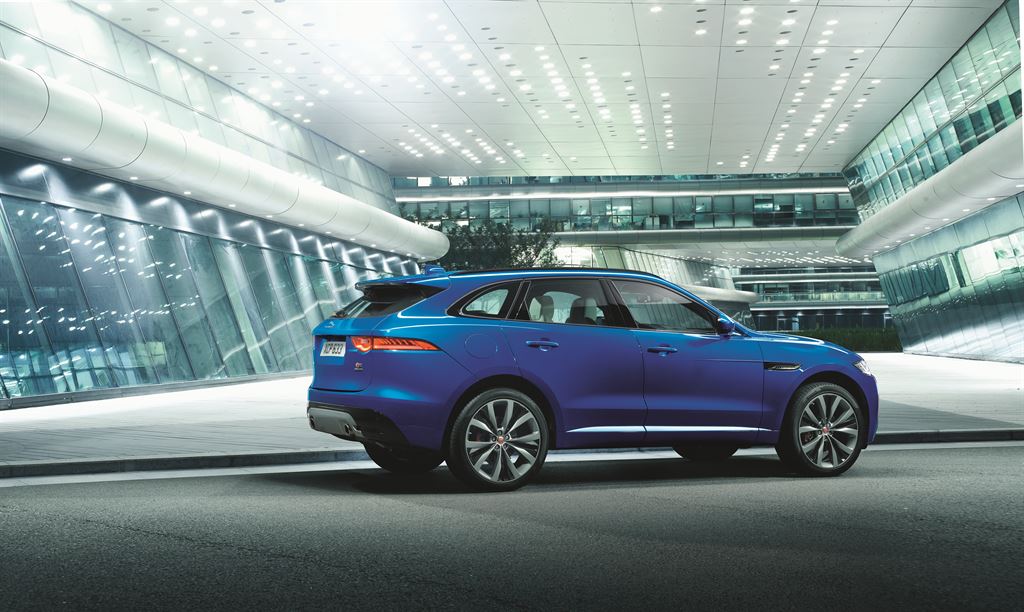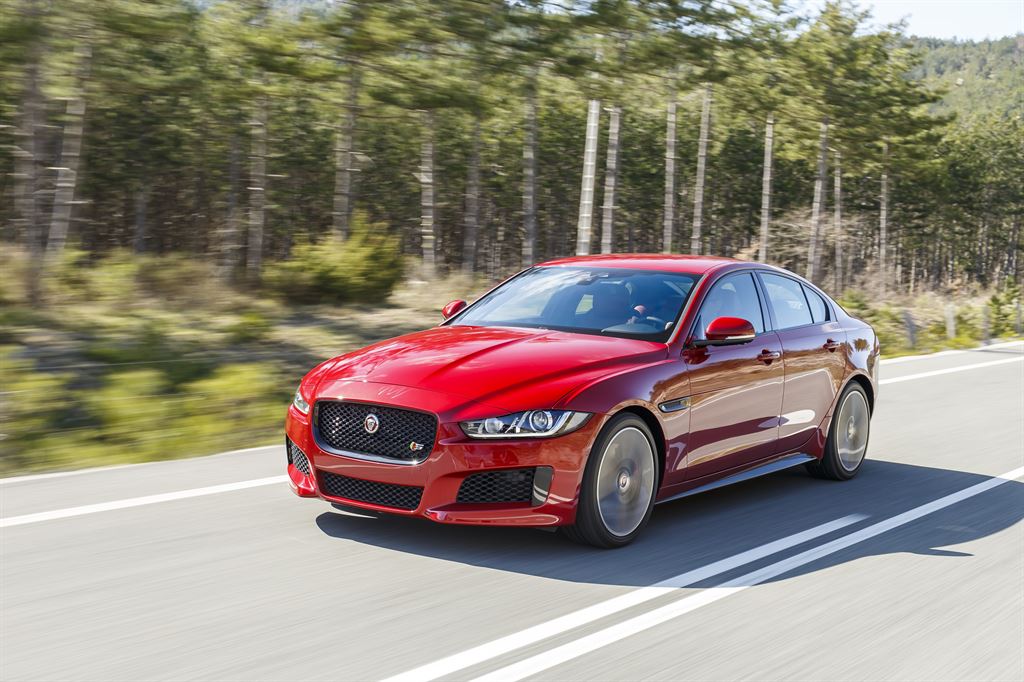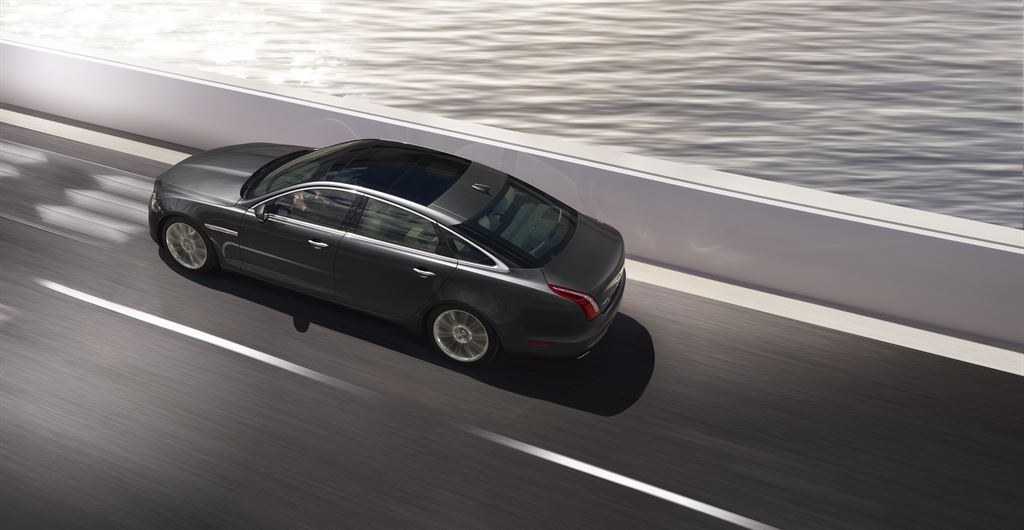Jaguar introduced its 2016 product offerings, representing The Next Generation of Jaguar. All of the 2016 vehicles — including two new models, F-PACE and XE, as well as the XF, XJ, and F-TYPE — will feature advanced aluminum construction, providing lighter weight, increased strength, and improved handling.
F-PACE

Debuted at the 2015 Frankfurt Motor Show, the all-new F-PACE is the first mid-size luxury SUV to join the Jaguar line-up. Using the full potential of the modular lightweight aluminum architecture, the F-PACE is designed and engineered to offer agility, responsiveness, and exceptional dynamics. “We designed the all-new F-PACE to be first and foremost a Jaguar. That’s why it has exciting proportions, a dynamic stance, pure surfaces and a beautiful sensuality about it,” said Ian Callum, director of design, Jaguar. “The Lightweight Aluminum Architecture gave us the design freedom to create a car with latent poise — a svelte car with attitude.”
Architecture
Outside, the clean lines of the bodysides are formed from a single sheet of aluminum — building upon the company’s decades-long expertise in designing, engineering, and manufacturing vehicles using this lightweight material. In fact, the F-PACE features the largest amount of the Jaguar-developed RC5754 aluminum alloy yet; one third of the vehicle features this lightweight material which comprises up to 75% recycled material.
In conjunction with the brand’s Lightweight Aluminum Architecture, new features such as a composite tailgate, magnesium cross-car beam and front-end carrier, and high strength steels in areas such as the rear floor, contribute to its outstanding driving dynamics.
The vehicle is joined together using more than 2,600 self-piercing rivets, 238.8 ft (72.8 m) of structural adhesive, and more than 560 spot-welds. The resulting torsional stiffness matches that of the all-new XF and, together with the advanced suspension systems, are key to the exceptional blend of ride, handling and refinement of the performance SUV.
Chassis
Using the long wheelbase of the Lightweight Aluminum Architecture helped keep the center of mass between the axles, while the chassis high stiffness benefits not only ride, but responsiveness. Aluminum is used almost exclusively to make the suspension as light as possible, most notably the front knuckles. The intricate, ribbed design is achieved by forging the component from cast blanks; enabling maximum stiffness for minimum weight.
The upper links are aluminum forgings, while the lower arm is hollow-cast aluminum — the optimum lightweight solution for this complex part. The springs and dampers are mounted separately, allowing each to be ideally positioned for the forces acting on the suspension and contributing even more to the dynamics and refinement of the F-PACE.
Suspension
The high-pressure diecast aluminum front suspension turrets, have been engineered to accommodate additional ground clearance and suspension travel of the vehicle. The front crossmembers are large, making them stiff to support the vehicle’s elevated, Sports Command driving position. The subframes and subframe mounting points have been engineered to contribute to greater overall stiffness without the weight and packaging penalties that come by simply adding body reinforcements. In fact, wherever possible, every bracket in the body has been optimized so that it contributes to body stiffness, as well as performing its primary function.
The SUV will enter North American markets in 2016 as a 2017 model.
XE

The all-new Jaguar XE is an aluminum-intensive compact sport sedan, designed to be a true driver’s car with streamlined styling, luxurious interior, and outstanding ride and handling. This is the first model designed around this the company’s all-new modular architecture, much of which is comprised of high-strength 6000-series aluminum alloy. As an example, the body sides are made from complex pressings formed in one piece; what would once have been 1.5 mm gauge sheet has been reduced to just 1.1 mm.
“The XE is as strong and light as it could possibly be thanks to exhaustive analysis and by bringing the latest engineering techniques to bear on its design,” said Dr. Mark White, chief technical specialist, Jaguar, Body Complete. “It has been challenging to accomplish but the XE structure is absolutely at the cutting edge of what is achievable today.”
Sustainability is a big part of the Jaguar aluminum story. Recycling this highly valuable material delivers impressive savings in overall CO2 emissions and the new XE uses RC 5754, an aluminum alloy made predominantly from recycled material. Future models will also use RC 5754 and this breakthrough will help Jaguar towards its goal of using 75 percent recycled material by 2020.
Riveting and bonding the lightweight body structure of the Jaguar XE consumes less energy than traditional spot welding. The XE also contains 101lbs. of recycled plastics and renewable materials, further reducing its environmental impact.
The new Jaguar XE features a sophisticated double wishbone front suspension. The aluminum front spindles are light and stiff, forged from cast blanks using a patented production process, while the rear suspension features an integral link system. This system delivers lateral and longitudinal stiffness for precise handling and a supple ride. Aluminum has been used extensively in the suspension, minimizing weight.
Manufacturing of the aluminum-intensive Jaguar XE occurs at Jaguar Land Rover’s Solihull, U.K. plant in an all-new facility, which was part of a £1.5bn investment. The Jaguar XE will arrive in North American showrooms spring 2016 as a 2017 model year.
XF

Fully redesigned for 2016, the second generation Jaguar XF is positioned between the mid-size Jaguar XE and the full-size Jaguar XJ. The new bodywork on the XF mirrors the evolution of the Jaguar design language, incorporating a sleek, coupe-like profile.
The move from an all-steel to an aluminum-intensive unibody leverages more than a decade’s experience of manufacturing luxury vehicles from aluminum in high volume. With the help of the new aluminum-intensive architecture, the 2016 XF sheds 132 lbs and 265 lbs over the outgoing 2015 RWD and AWD models respectively. The one-piece aluminum body side pressings contribute not only to the overall stiffness of the body, but also to surface purity and quality as there are no visible joints. Aluminum is also used to make the hood and front fenders, while the front-end carrier and cross-car beam are cast from even lighter magnesium alloys.
5000-series aluminum alloy pressings are used where stiffness is a key, such as in the underframe reinforcements. These include RC5754, a grade unique to Jaguar Land Rover, which is made predominantly from recycled material. Around half of this is scrap sourced from the press shops, helping not only the move towards closed-loop recycling but also reductions in overall electricity consumption and therefore lifecycle CO2 emissions.
Assembly of the structure uses a two-stage framing process. The technique allows for greater joint efficiency through optimized positioning of the rivets. This translates to increased torsional rigidity of the body, making the all-new Jaguar XF up to 28% stiffer than its predecessor. Features such as the high-pressure die-cast aluminum front suspension towers increase local stiffness and make a significant contribution to the ride, handling and steering of the all-new XF.
“The all-new XF has to deliver both driver reward through agility and immediacy of response when it’s called for, and yet great ride composure and comfort too,” said Mike Cross, chief engineer of Vehicle Integrity, Jaguar. “The light and rigid aluminum intensive architecture of the all-new XF is a key enabler for us delivering those attributes, as it provides an optimal basis for finely tuning the ride and handling characteristics of the car. The result is that the new XF is as satisfying to drive quickly, as it is comfortable to be driven in.”
XJ & F-TYPEs
Both the 2016 XJ and F-TYPE models continue to feature all-aluminum construction reducing weight and improving performance, each incorporating new design and performance features.
Lightweighting Strategy
In an interview with The Aluminum Channel™, Dr. Mark White, chief engineer Body Complete Business Unit, Jaguar Land Rover, discusses Jaguar Land Rover’s Light Weight Vehicle Strategy and what that means for aluminum. He directly links ride, handling, NVH, CO2 emission compliance, fuel economy, and the unparalleled driving experience of these vehicles to the aluminum unibody construction in combination with minimum drag coefficients and high performance powertrain solutions.
